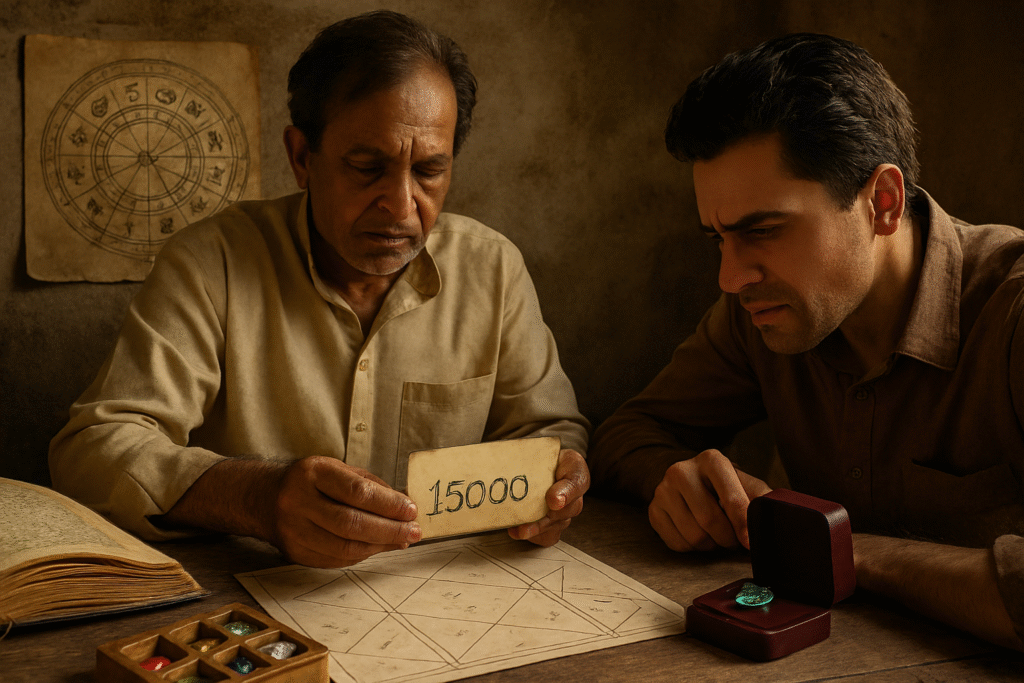When shopping for gems and jewelry, you need to follow practical rules that protect your money and guarantee quality.
- Always buy from a trusted jeweler
- Always ask for a detailed receipt
A reliable jeweler gives you authenticity and accountability. A proper receipt documents purity, gemstone type, and any warranty.
How to Inspect Jewelry Before Buying
Use a 10x magnifying lens. Check:
- Settings: Are the stones held firmly?
- Metal markings: Look for purity marks such as 22K, 18K, 925 (silver), or Pt950 (platinum).
- Maker’s mark: A traceable hallmark adds credibility.
- Stones: Examine for chips, cracks, or flaws that affect beauty and durability.
💡 The key is simple: You rarely find bargains in the gem world. Quality comes at a fair price.
Why Low Prices Can Be Risky
Cheaper jewelry may signal:
- Lower quality materials
- Incorrect labeling (e.g., citrine sold as topaz, or green glass sold as jade)
- Misleading trade names
Research shows that over 60% of jewelry complaints involve misrepresentation of gems.
Understanding Gemstone Value
The value of a gemstone depends on:
1. Color
- Strong, natural colors fetch higher prices.
- Lighting affects how you see color. Always check under natural light.
2. Clarity
- Diamonds, topaz, aquamarine, and tanzanite are judged strictly on inclusions.
- Emeralds and red tourmalines almost always show inclusions, so grading is more lenient.
3. Cut
- Proportions and finish affect sparkle and durability.
- Poorly cut stones may break more easily.
- A high-quality cut improves brilliance by up to 30% compared to average cuts.
4. Carat Weight
- Larger gems cost more per carat because they’re rarer.
- Stones above 40 carats may drop in value if they become impractical for jewelry use.
Case Example: Emeralds
An emerald with vivid green color but visible inclusions can cost more than a flawless light-colored stone. The market pays for intensity of color, not just clarity.
FAQ: Shopping for Gems and Jewelry
Q: What documents should I ask for when buying jewelry?
A: Always request a bill with details on purity, stone weight, and certification.
Q: Are bargains in gemstones real?
A: Rarely. A low price often means poor quality or misrepresentation.
Q: Which factor affects gemstone price the most?
A: Color. For example, a fine blue sapphire can be 50% more expensive than a similar but paler stone.
Q: How do I avoid buying fake jade?
A: Ask for a gemological certificate and avoid vague labels like “jade-like stone.”
Quotable Insights
- “You rarely find true bargains in the gem market. Value is tied to quality and trust.”
- “Color is the single biggest driver of a gemstone’s price.”
- “A skilled cut can increase brilliance by 30% or more.”
India Regional Cultures: A Complete Diversity Guide
India regional cultures are as diverse as its landscapes. This guide explores traditions, languages, and unique identities across the country. India Speaks FAQ on regional cultures reveals remarkable diversity across the subcontinent. Each state tells a unique story of tradition, heritage, and identity.
This India Speaks FAQ on regional cultures explores how geography, history, and local customs shape the cultural differences across India’s states and territories.
Understanding these regional differences helps you appreciate India’s true cultural richness.
What Makes India’s Regional Cultures Unique?
Each state develops its own distinct language, cuisine, and customs over centuries. Local history shapes traditions and daily life. Geography influences everything from clothing styles to building designs and lifestyle choices.
Examples of regional adaptation:
- Kashmir’s wooden homes with sloped roofs handle heavy snowfall
- Kerala’s houseboats work perfectly with extensive waterways and monsoon climate
- Rajasthan’s thick-walled buildings stay cool in desert heat
These regional adaptations show how different communities respond to their environment while keeping cultural identity.
How Do Regional Foods Reflect India’s Cultural Diversity?
Regional cuisine connects directly to local climate and crops. Coastal regions favor rice cultivation and seafood preparation. Northern states rely on wheat-based breads like roti, naan, and paratha.
Cooking methods vary significantly across regions:
- Mustard oil dominates Bengali cuisine
- Coconut oil is essential in Kerala cooking
- Ghee remains the preferred fat in Rajasthani dishes
When you travel across India, pay attention to these culinary differences. They reveal stories about the land, climate, and cultural preferences. India Speaks FAQ on regional cultures shows these food traditions matter.
Why Are Languages Central to Regional Identity in India?
India speaks through 22 official languages and hundreds of regional dialects. Each language carries unique cultural meaning. Language shapes traditional songs, folk tales, religious festivals, and social customs.
Language examples and their cultural significance:
- Tamil expresses the rich Dravidian heritage of South India
- Punjabi reflects Sikh traditions and agricultural lifestyle
- Bengali carries the literary legacy of Nobel laureate Rabindranath Tagore
- Hindi serves as a connecting language across northern states
Learning even a few local words helps you connect with regional communities. It shows respect for local culture.
What Role Do Festivals Play in India’s Regional Cultures?
Festivals serve as powerful expressions of regional identity. They bring communities together through shared traditions and celebrations. Each region celebrates differently based on local customs, crop cycles, and religious practices.
Regional festival examples:
- North India illuminates Diwali with millions of oil lamps and fireworks
- South India honors Pongal with harvest rituals celebrating farmers and nature
- West Bengal transforms during Durga Puja with art installations, classical music, and community feasting
Each festival reflects the unique cultural values and historical experiences of its region.
Which festival would you want to experience firsthand?
How Does Traditional Clothing Vary Across Indian Regions?
Climate conditions and available resources influence regional clothing styles across India. These variations demonstrate practical adaptation to different environments while maintaining aesthetic preferences.
Regional clothing examples:
- Rajasthan’s desert climate inspires bright turbans, flowing skirts, and mirror-work textiles that reflect heat
- Kerala’s humid tropical climate favors white cotton sarees with golden borders worn during festivals
- Nagaland’s mountainous terrain produces distinctive shawls featuring tribal symbols and geometric patterns
Each style represents clan identity and cultural heritage specific to its region.
How Do Regional Crafts and Arts Represent Cultural Identity?
Traditional crafts carry centuries of accumulated skill and cultural meaning. They serve as living expressions of regional identity. These art forms express creativity through traditions passed down through generations.
Regional craft examples:
- Bihar’s Madhubani paintings feature mythological themes and geometric patterns created by women during festivals
- Kerala’s Kathakali dance combines dramatic storytelling, classical music, and elaborate costumes
- Odisha’s traditional metalwork, particularly brass and bronze artifacts, carries deep ritual meaning in temple worship
Supporting these regional crafts helps preserve cultural heritage. It provides sustainable livelihoods for traditional artisans.
Why Should You Explore India’s Regional Cultures?
Exploring regional cultures offers experiences beyond visiting monuments and tourist attractions. You engage directly with daily life, authentic cuisine, and living languages.
Regional travel provides meaningful context rather than surface-level tourist highlights.
Benefits of regional cultural exploration:
- You connect with local communities on a personal level
- You taste authentic dishes prepared with traditional methods
- You hear regional languages and dialects in natural settings
- You witness festivals and ceremonies as they happen in daily life
Each regional visit deepens understanding of India’s diversity. It helps you appreciate how different communities adapt to their environments while keeping distinct cultural identities.
India Speaks FAQ on regional cultures demonstrates what makes the country culturally rich and endlessly fascinating for travelers and cultural enthusiasts.
Which region would you choose to explore first?



